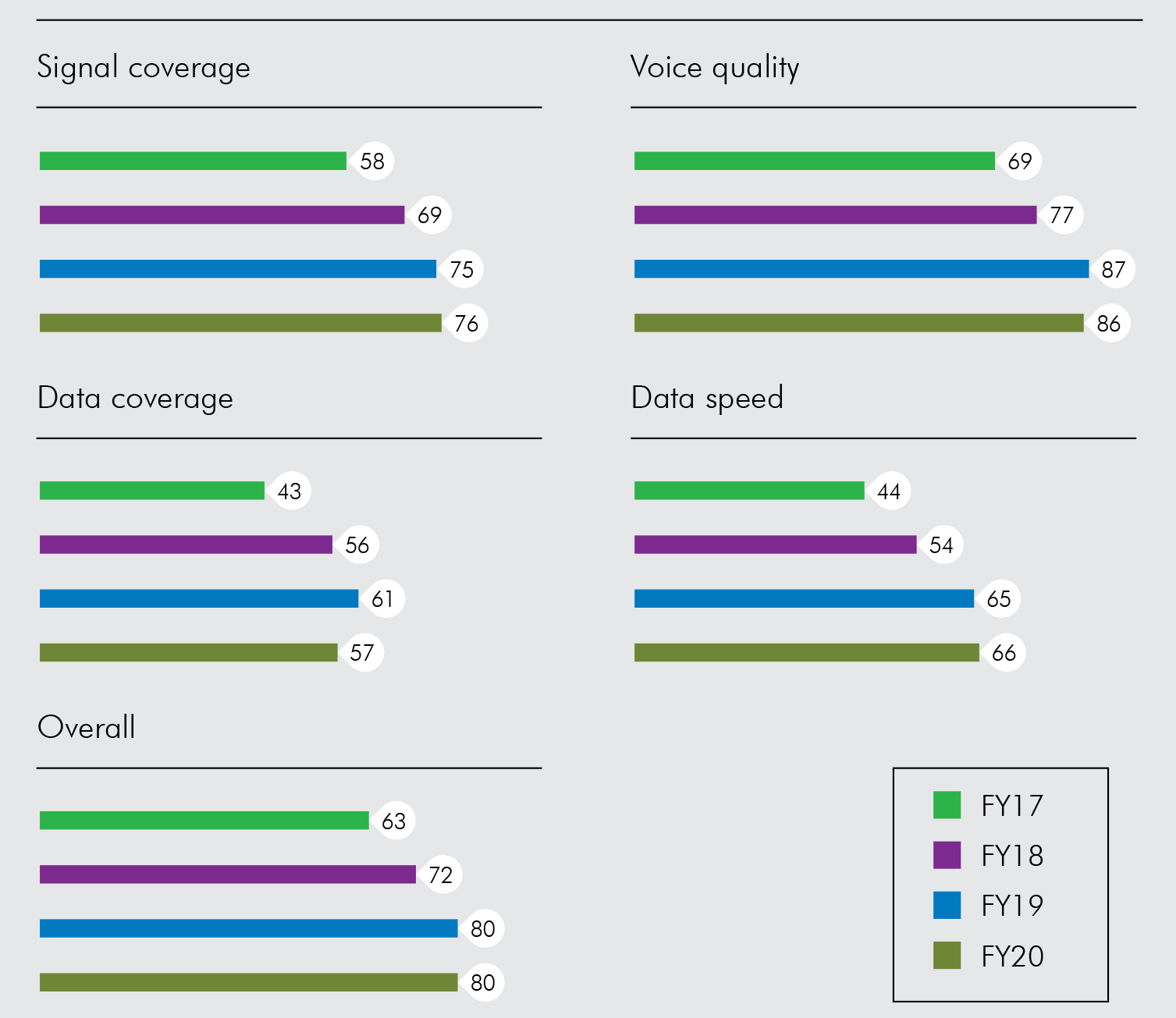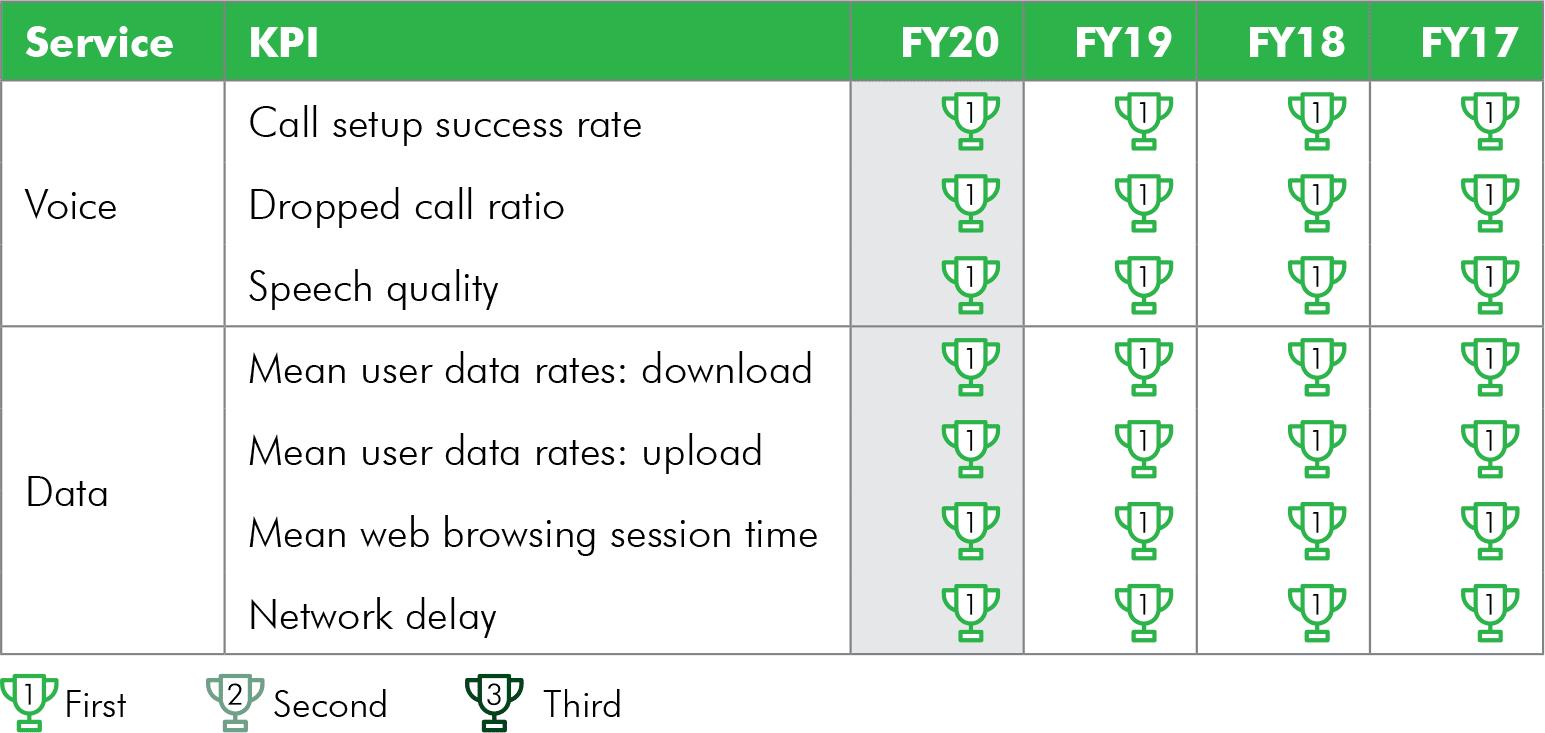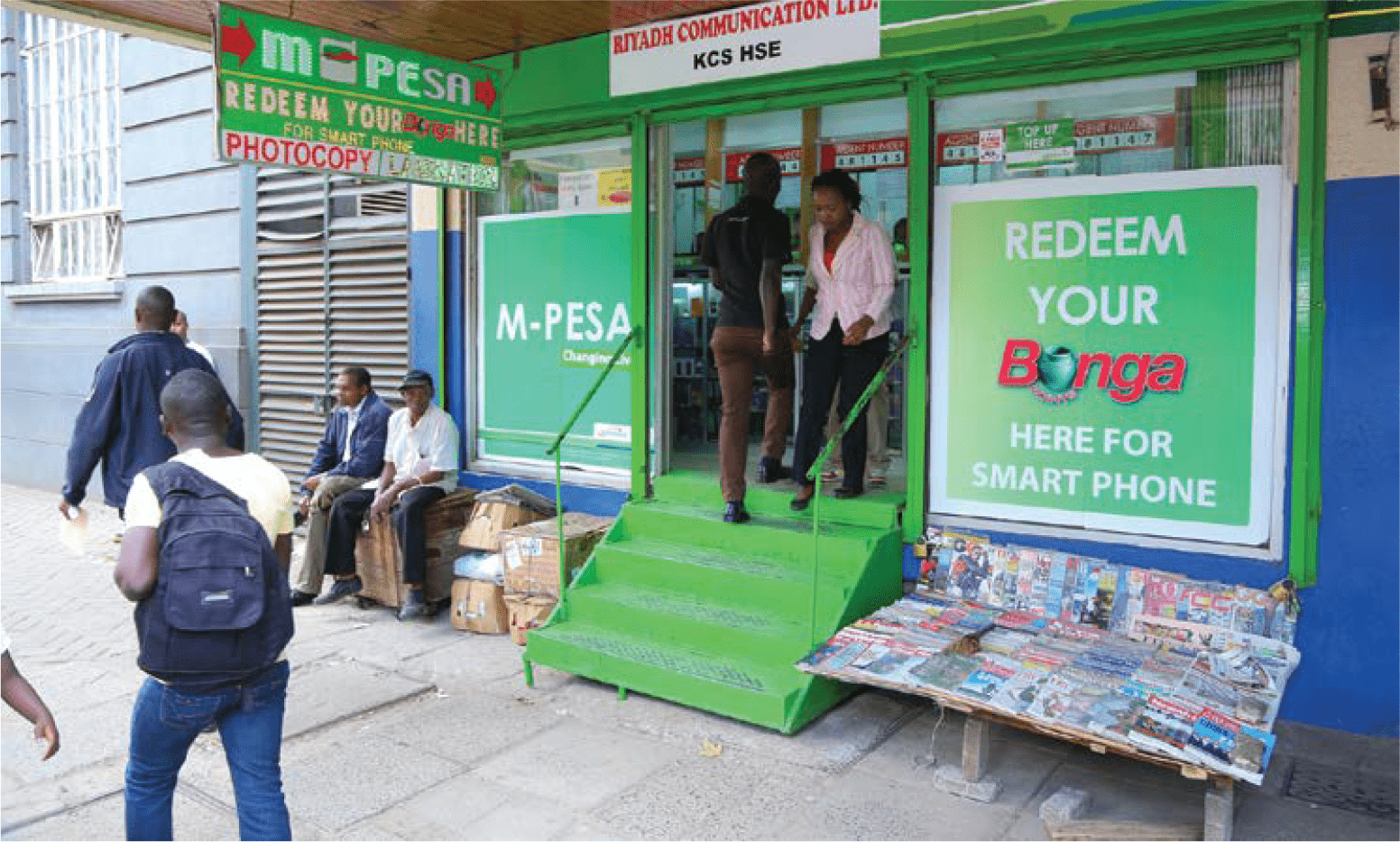Our network



We are committed to developing reliable, sustainable and resilient network infrastructure and to providing universal and affordable access to data for all. We have set targets to roll out 4G coverage to 80% of the Kenyan population and to extend our fibre optic footprint.
Our Network is the core foundation of our business. It is the platform through which we deliver our products and services and on our promise to transform lives. Our network is a piece of critical infrastructure that facilitates inclusive, sustainable economic development and innovation. We recognise the role that network connectivity plays in relation to building socio-economic resilience in societies. The critical components of our network are quality, availability and coverage. We remain committed to building a network infrastructure that is resilient.
Network quality
We continue to use independent QoS testing to monitor and manage the quality of our network. According to the results of the tests conducted by Umlaut1 (www.umlaut.com), we maintained our first-place position across all seven voice and data service categories. We attribute this to several initiatives, including the rollout of additional 4G-enabled sites (thereby improving coverage), upgrading our backbone transmission capacity and increasing overall capacity within the core network (supporting increased levels of data traffic), ongoing optimisation initiatives (improving user call and data experience), and sustained efforts to improve network availability.
![]() Customer satisfaction
Customer satisfaction
Customer satisfaction is the heart of our business and the most important metric we measure. We use the network-related Net Promoter Score (NPS) to help us measure the contribution the performance of our network makes to customer satisfaction. The NPS is an independent survey of customer satisfaction and the ‘Network NPS’ metric allows us to monitor whether our customers are experiencing the improvements we make to the network. While NPS is a useful indicator, it is important to note that it measures customer perceptions and opinions regarding network performance, not actual network performance.
Network NPS
Independent Quality of Service (QoS) test results
As the preceding graph shows, our overall Network NPS remained stable and was 80 in March 2020. The table also illustrates the breakdown of different network elements used to determine the overall NPS. While we are satisfied with the results, we believe that the tremendous surge in traffic we experienced at the end of the reporting period – an increase of 100% in data traffic year-on-year – may have reduced customer satisfaction levels.
New customer experience evaluation tool to drive network NPS improvements
One of our focus areas during the year was the development of an in-house customer experience evaluation tool, called the Customer Experience Management or CEM tool. The new tool will use bespoke KPIs that we are designing to monitor, manage and improve the customer experience for our different customer segments and their specific needs. Drawing on a wide range of network touch points and sophisticated deep packet analysis, the tool will enable us to visualise and predict customer experiences across the network.
The purpose of the tool is to provide us with more accurate and useful information in terms of what aspects of the network are impacting customer experiences. It reflects our Tech 3.0 commitment to drive our decision making with faster and more precise data and to upskill our engineers and in-house teams.
Network expansion
As per previous years, we focused on expanding fixed and mobile broadband coverage to meet growing demands for data connectivity and faster data speeds in the year under review. Driving growth for data connectivity and enhancing the experience of our customers was a key focus area for the business in FY20. This involved rolling out sites, especially 4G-enabled sites, migrating existing sites from microwave to fibre connections, and continuing with the aggressive expansion of our fibre optic network.
During the year, we rolled out an additional 365 2G-enabled sites and provide 96% of the population with access to 2G services. We also deployed an additional 368 3G-enabled sites, many of these were in rural areas and this equates to providing an additional two per cent of the population with coverage.
To support our ambition of digitising our customers, we continued our aggressive expansion of 4G-enabled sites during the year. We added 1 551 4G-enabled sites to the network and extended 4G services to an additional 20 per cent of the population as a result.
We are delighted to report that we added an additional 2 300 kilometres to our fibre optic network during the year. We continue to support businesses of all sizes and connected an additional 1 536 enterprise buildings. We also made good progress in terms of residential homes, passing an additional 42 105 houses and connecting 34 238 homes to the network. As a result, we have connected over 142 000 homes and 11 911 businesses to our fibre optic network to date.
We attribute this excellent progress to our ongoing strategic intent to become the digital services provider of choice for Kenyans. Accordingly, we set ourselves ambitious targets for the year and sustained our high levels of investment, with capital expenditure of KSh 36.1 billion.
“We attribute this excellent progress to our ongoing strategic intent to become the digital services provider of choice for Kenyans. [We] set ourselves ambitious targets for the year and sustained high levels of investment, with capital expenditure of KSh 36.1 billion.”
![]() Network expansion
Network expansion
Focus on VoLTE
Long-Term Evolution (LTE) standards will remain the foundation for wireless broadband communication in many parts of the world for at least the next 10 years. We consider LTE an important stepping stone for Kenyan consumers migrating towards 5G-enabled services. The benefits of VoLTE include better voice clarity and quicker call set up (i.e. calls sound better and get connected quicker). We have more than one million VoLTE-enabled (voice over long-term evolution) phones connected to the network and aim to increase this significantly in the short- to medium-term through affordable handset campaigns, triple play offerings for fixed customers, redefined Hosted PBX services and by introducing supplementary VoLTE and VoBB (voice over broadband) services and solutions.
Network availability and stability
Network availability and stability is important because an unavailable or inaccessible network means that our customers experience is impacted and that they are unable to access our services and perform tasks.
Network performance
The most significant challenge to energy availability and, hence, the Network Unavailability Rate (NUR) remains unreliable power from the national grid. It was responsible for between 40 and 47 per cent of unavailable minutes across both macro and micro sites during the year. The increase in our Service Unavailability Rate (SUR) was caused by service disruptions during the modernising of sites in the Nairobi East and Coast regions.
![]() Looking ahead
Looking ahead
- We will continue our initiatives to improve the transmission capacity on the core network to guarantee excellent mobile data experiences in spite of the anticipated growth in data traffic.
- We will continue the accelerated rollout of 4G services and 4G-enabled sites. Our target is to deploy an additional 1 400 4G-enabled sites in FY20, and, ultimately, to transition the entire network to 4G.
- We plan to conclude our trials of 5G-enabled sites and commission 50 commercial sites during FY20.
- We will continue our aggressive roll out of fibre connectivity to support remote working, learning and general connectivity.
- We will continue to develop our customer experiences evaluation tool (CEM) and use automated analytics and insights proactively to improve the way customers experience the network.






